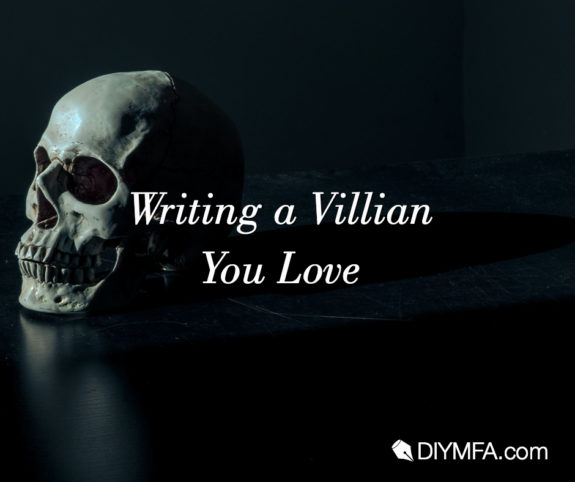A good friend once asked me who my favorite literary character was and why. I immediately responded with Mary Katherine (Merricat) Blackwood from We Have Always Lived in the Castle. As I described Merricat—destructive, chaotic, manipulative—my friend interrupted to ask why I liked her. Clearly someone with so many negative qualities was the villain of the story. Wasn’t the hero of the story more interesting and likable?
The villain is often viewed as a necessary evil in our stories. They’re created for the sole purpose of messing up our hero’s life and don’t have much of a role beyond that. Sometimes we even create a villain without any redeeming qualities so our readers are naturally attracted to our heroes. Writing our villains this way can feel forced or boring as we ignore their character development and shape them to fit our plot.
But what if I told you that villains were more than just antagonists and had deeper, more complex roles? In fact, the villain is one of the most important characters you’ll write because they drive the tension, plot, and growth of our heroes. Without the villain, your hero isn’t a hero.
So how do you write a villain you love? A villain that’s interesting, engaging, and maybe even likable. They exist to inspire your plot instead of filling the holes, and sometimes they’re more fun to write than your hero. Here are some ways to write a villain that you and your readers love.
Give your villain someone to love (who loves them back)
Nothing humanizes a character more than showing love for someone. Just knowing that a character cares for someone else demonstrates their vulnerability and humanity. It also provides that character with depth so they’re not one-dimensional or a cliché.
Giving your villain someone to love can also provide context for their goals, motivations, or actions. It can help readers sympathize or relate with the villain if they understand they’re driven by love for another person. Or it can provide a source of conflict or tension if the villain and hero love the same person.
Once you give your villain someone to love, consider setting that character up to love your villain back. If someone else loves your villain, they become a more sympathetic and intriguing character. It’s similar to the concept of social proof—the psychological and social experience where people mimic the actions of other people in order to exhibit the “correct” behavior in a given situation. If readers witness another character showing affection towards your villain, they might be more inclined to appreciate your villain.
If you decide to go this route, I recommend giving your villain someone or something animated to love. A villain who loves their family or a pet is more interesting than a villain who loves money or a philosophical idea. The person or pet doesn’t need to make an appearance in the story; they can be an offscreen character that your villain reflects on or thinks about. They can even be a major component of the villain’s backstory.
Include their backstory
Villains are individuals and while they drive tension and conflict, it doesn’t define them. They have their own thoughts, habits, memories, weaknesses, pet peeves, etc. They’re also influenced by events in their past that inform their emotional, physical, and psychological responses.
To help reveal these past events and give context to the events in your story, it’s important to develop your villain’s backstory. This can include defining moments from their childhood, an encounter with the protagonist, or their life before the main action of your story. These moments can help you develop their thoughts, feelings, actions, motivations—pretty much everything! Their backstory is also the key for why they’re antagonizing your hero.
I recommend sketching out your villain’s backstory as if they’re the protagonist of their own story. Creating them as an individual character, not just a foil for your hero, can help unlock their inner workings and avoid clichés. Develop your villain without thinking about what you need from them in order to make your plot work. Let their personalities reveal where potential conflicts may arise.
It’s the writer’s choice on how and when you want to include a villain’s backstory in the larger work. Be careful not to include their full backstory as this could slow down your pacing or detract from your hero’s story. Instead, gradually reveal their backstory throughout and use it to give context to certain events. Try to show, rather than tell, the villain’s backstory through dialogue, memories, or keeping the action in the current timeline.
Mirror your hero
One technique to help create a compelling and well-developed villain is to have their journey parallel the hero’s journey. Some of the most interesting villains in literature have the same goals as the hero, however they’ve chosen a different way to achieve them. A classic example is Darth Vader and Luke Skywalker. Both are powerful characters that can wield the force, but have chosen different ways to use their gift.
That’s the key though—they choose to achieve their goals and use their gifts in a certain way. Darth Vader’s journey is a reflection or prediction of Luke’s fate if he chose to use the force differently.
Here’s where you get to have some fun when writing your villain. All of the things that you love about your hero you can exaggerate or intensify in your villain. For example, maybe your hero loves to read, however would stop short at stealing an ancient tome from a library. Your villain could also love to read but chooses to steal the book instead. While your hero may need to practice restraint for the good of the story, you can let your villain run wild and see where it takes them.
An unrestrained villain holds up a mirror to your hero and shows them the consequences of their choices. Your hero may see themselves in your villain and worry they could end up the same way. This could give your hero motivation to make certain decisions or avoid certain actions. Meanwhile, giving you room to explore what it looks like on the other side with your villain.

Ginnye Lynn Cubel is a writer, podcast host, and coffee enthusiast. She is working on her first novel Ophelium, a dark and magical take on the story of Ophelia and the repercussions of insanity. You can follow along on her website or on Twitter and Instagram.







